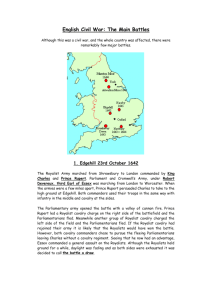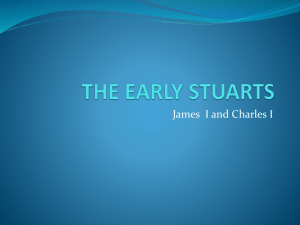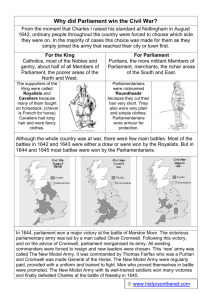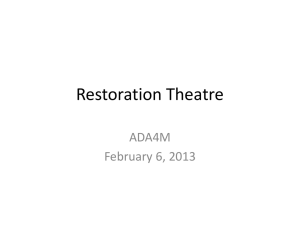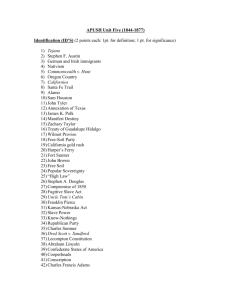Civil War - csi2007hg
advertisement
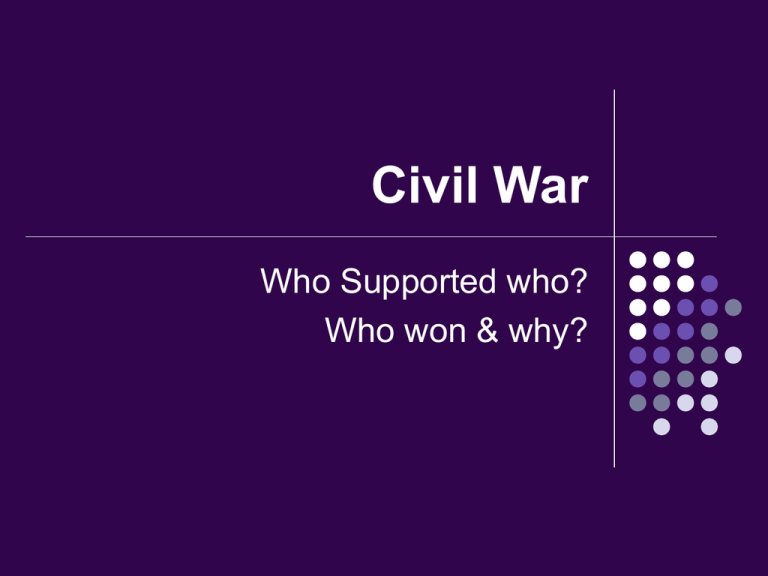
Civil War Who Supported who? Who won & why? Royalist or Parliamentarian? Who fought for whom? For the King Catholics, most of the Nobles and gentry, about half of all Members of Parliament, the poorer areas of the North and West. Cavaliers The supporters of the King were called Cavaliers because many of them fought on horseback. The term comes from the French 'chevalier' meaning 'horse'. Cavaliers had long hair and wore fancy clothes. For Parliament Puritans, the more militant Members of Parliament, merchants, the richer areas of the South and East. Roundheads Parliamentarians were nicknamed 'roundheads' because they cut their hair very short. They also wore very plain and simple clothes. Organisation, pay & training The 1st battles of the Civil War were more like street fights than battles. No one expected the war to last long and so no one had really thought about feeding and paying the soldiers. At Marston Moor in 1644, Royalist supplies were so low that the soldiers had to drink water from ditches. Cromwell and Sir Thomas Fairfax soon realised that if the King was to be beaten, they would have to form a well trained army. In 1645 they set up the New Model Army. This was really important in winning the Battle of Naseby in 1645. Parliament controlled London & the richest parts of England, so they could afford to pay their soldiers. Charles hoped the kings in Europe would help, but they never did. The Main Battles Although this was a civil war, and the whole country was affected, there were remarkably few major battles Edgehill 23rd October 1642 Both the Royalist and the Parliamentary armies were on the move. Charles' army, commanded by the King himself, was marching from Shrewsbury to London while Cromwell's army, under Robert Devereux, third Earl of Essex was marching from London to Worcester. When the armies were a few miles apart, Prince Rupert persuaded Charles to take to the high ground at Edgehill. Essex realised that the Royalist army was close and formed his men for battle. The Parliamentary army opened the battle with a volley of cannon fire. Prince Rupert led a Royalist cavalry charge on the right side of the battlefield and the Parliamentarians fled. Meanwhile another group of Royalist cavalry charged the left side of the field and the Parliamentarians fled. If the Royalist cavalry had rejoined their army it is likely that the Royalists would have won the battle. However, both cavalry commanders chose to pursue the fleeing Parliamentarians leaving Charles without a cavalry regiment. Seeing that he now had an advantage, Essex commanded a general assault on the Royalists. Although the Royalists held ground for a while many soon decided to run. However, Essex had thought of this and had sent a cavalry regiment to the back of the field to cut down any who chose to flee the battlefield. They did not get the chance to do this as Prince Rupert had returned with his cavalry. The light was giving way to darkness by now and as both sides were exhausted it was decided to call the battle a draw. Marston Moor 2nd July 1644 Prince Rupert was marching across the North of England to relieve a Royalist army trapped in York. News of Rupert's position in the North reached Oliver Cromwell, the Parliamentary Lieutenant General, and an army was sent to meet the Royalists. Rupert outmanoeuvred the Parliamentarians by sending a cavalry detachment south to Marston Moor while taking the rest of the Royalist army to York and then to Marston Moor by a Northern route. Meanwhile, Rupert sent a message to William Cavendish, Duke of Newcastle, to meet him at Marston Moor. The combined Royalist forces were outnumbered by the Parliamentarians but decided to fight anyway. They reached their battle positions in the early evening and assumed that the battle would not begin until the early morning. Unfortunately for them the Parliamentarians had decided to mount an attack that evening and the Royalists were totally unprepared for the attack. For the first time since the Civil War had began. Rupert's cavalry, at one end of the field, were beaten by a Parliamentarian cavalry charge. Things were better for the Royalists at the other end of the field where the Parliamentarians had been beaten back. Having defeated Rupert, the Parliamentarians were feeling optimistic and successfully defeated the Royalist infantry, killing those who did not flee. The Battle of Naseby 14th June 1645 The Parliamentarian, General Fairfax, had laid siege to Oxford in a bid to lure Charles into battle. Hearing that his Royalist 'capital' had been placed under siege Charles had immediately marched to Oxford to release the city. As Charles neared Oxford, Fairfax broke the siege and marched north to meet Charles. Not wanting to be forced into battle against Fairfax, Charles turned north. Unfortunately for the Royalists, they could not outmarch the Parliamentarians and had no choice but to turn and fight. They took up a good defensive position and waited for word of Fairfax's position. Prince Rupert discovered that the Parliamentarians were camped near Naseby and suggested that the Royalists should advance on Fairfax. The decision to advance was taken and the Royalists left their strong defensive position to make an attack. This was not a good decision as Fairfax had deployed his army in a very strong position, going so far as to hide some of his troops from sight. The Parliamentarian New Model Army then took to the field concentrating mainly on the Royalist infantry. Charles' army were unable to withstand this new attack and many foot soldiers surrendered. The battle lasted just three hours and in that time most of the Royalist foot soldiers were killed or taken prisoner. The Royalists also lost all of their artillery and most of their baggage. Charles fled the battlefield as soon as it became apparent that he had lost the battle.
